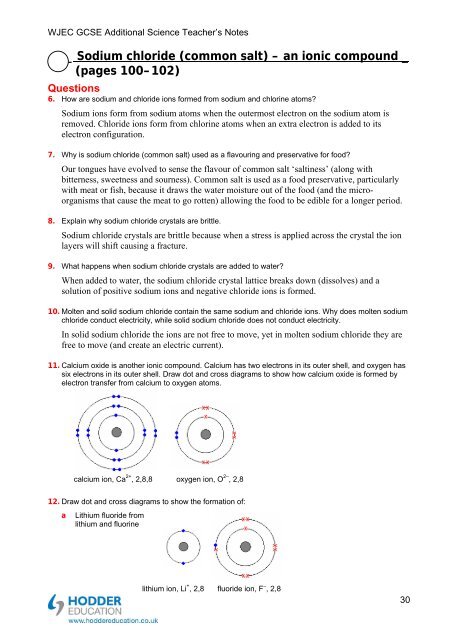Teacher's notes and answers to questions in the book - Hodder Plus ...
Teacher's notes and answers to questions in the book - Hodder Plus ...
Teacher's notes and answers to questions in the book - Hodder Plus ...
You also want an ePaper? Increase the reach of your titles
YUMPU automatically turns print PDFs into web optimized ePapers that Google loves.
WJEC GCSE Additional Science Teacher’s Notes<br />
_ Sodium chloride (common salt) – an ionic compound _<br />
(pages 100–102)<br />
Questions<br />
6. How are sodium <strong>and</strong> chloride ions formed from sodium <strong>and</strong> chlor<strong>in</strong>e a<strong>to</strong>ms<br />
Sodium ions form from sodium a<strong>to</strong>ms when <strong>the</strong> outermost electron on <strong>the</strong> sodium a<strong>to</strong>m is<br />
removed. Chloride ions form from chlor<strong>in</strong>e a<strong>to</strong>ms when an extra electron is added <strong>to</strong> its<br />
electron configuration.<br />
7. Why is sodium chloride (common salt) used as a flavour<strong>in</strong>g <strong>and</strong> preservative for food<br />
Our <strong>to</strong>ngues have evolved <strong>to</strong> sense <strong>the</strong> flavour of common salt ‘salt<strong>in</strong>ess’ (along with<br />
bitterness, sweetness <strong>and</strong> sourness). Common salt is used as a food preservative, particularly<br />
with meat or fish, because it draws <strong>the</strong> water moisture out of <strong>the</strong> food (<strong>and</strong> <strong>the</strong> microorganisms<br />
that cause <strong>the</strong> meat <strong>to</strong> go rotten) allow<strong>in</strong>g <strong>the</strong> food <strong>to</strong> be edible for a longer period.<br />
8. Expla<strong>in</strong> why sodium chloride crystals are brittle.<br />
Sodium chloride crystals are brittle because when a stress is applied across <strong>the</strong> crystal <strong>the</strong> ion<br />
layers will shift caus<strong>in</strong>g a fracture.<br />
9. What happens when sodium chloride crystals are added <strong>to</strong> water<br />
When added <strong>to</strong> water, <strong>the</strong> sodium chloride crystal lattice breaks down (dissolves) <strong>and</strong> a<br />
solution of positive sodium ions <strong>and</strong> negative chloride ions is formed.<br />
10. Molten <strong>and</strong> solid sodium chloride conta<strong>in</strong> <strong>the</strong> same sodium <strong>and</strong> chloride ions. Why does molten sodium<br />
chloride conduct electricity, while solid sodium chloride does not conduct electricity.<br />
In solid sodium chloride <strong>the</strong> ions are not free <strong>to</strong> move, yet <strong>in</strong> molten sodium chloride <strong>the</strong>y are<br />
free <strong>to</strong> move (<strong>and</strong> create an electric current).<br />
11. Calcium oxide is ano<strong>the</strong>r ionic compound. Calcium has two electrons <strong>in</strong> its outer shell, <strong>and</strong> oxygen has<br />
six electrons <strong>in</strong> its outer shell. Draw dot <strong>and</strong> cross diagrams <strong>to</strong> show how calcium oxide is formed by<br />
electron transfer from calcium <strong>to</strong> oxygen a<strong>to</strong>ms.<br />
calcium ion, Ca 2+ , 2,8,8 oxygen ion, O 2– , 2,8<br />
12. Draw dot <strong>and</strong> cross diagrams <strong>to</strong> show <strong>the</strong> formation of:<br />
a<br />
Lithium fluoride from<br />
lithium <strong>and</strong> fluor<strong>in</strong>e<br />
lithium ion, Li + , 2,8<br />
fluoride ion, F – , 2,8<br />
30

















